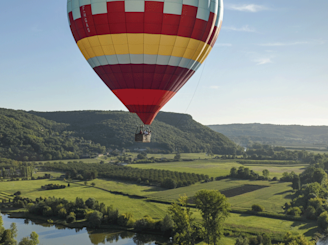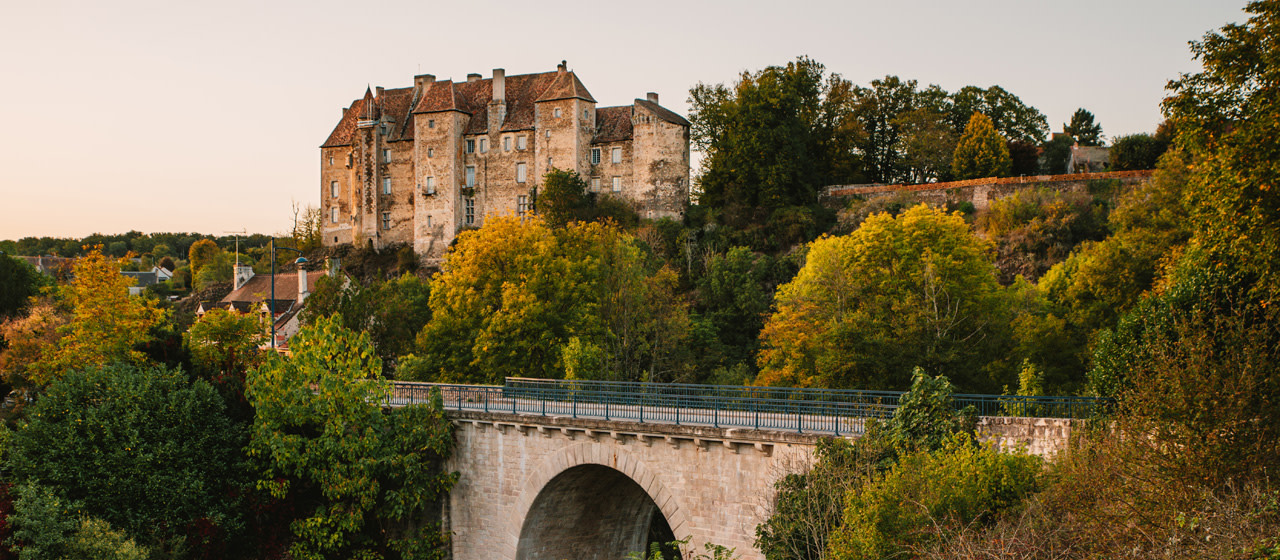As covering the full region in 6 days is quite simply impossible, some tough choices had to be made. In the end, we settle on an itinerary that sees us spending 3 days in the – relatively unknown – department of Creuse and 3 days in the Perigord Vert (otherwise known as Northern Dordogne).
Getting there: The high-speed train from Brussels to Bordeaux takes roughly 4 hours. It requires one simple change in Paris.
Day One - Driving direction La Creuse
Rental car picked up, GPS installed and appropriate playlist chosen, we embark on our journey to the Creuse department direction out locally run B&B Domaine de la Jarrige. We arrive just as the heat of the day dissipates and the lovely golden glow spreads across the landscape draping the little medieval villages we pass along the way in a blanket of warmth and coziness.
Driving: The drive from Bordeaux to La Creuse is roughly 3-hours. No tolls are paid on this stretch of the road.
Sleeping: For the first three nights we opted to sleep in B&B Domaine de la Jarrige. Every evening we have dinner together with other guests at a communal table and talk about France, the country and anything under the sun. This is the beauty of staying locally.
Day Two - Monts de Guéret, Glénic & a few surprising castles
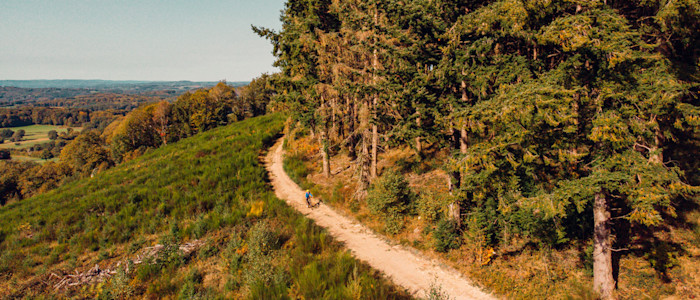
After what felt like the best sleep I had in ages, we head out for our first full day of adventure in the Monts de Guéret. Today is all about nature and outdoor sports! Our guide, Nicolas, is taking us on an electric mountain bike tour followed by outdoor climbing. I must admit, I am ever so slightly nervous, being a complete novice at both.
Those nerves soon dissipate as Nicolas shows us how the electric mountain bike works and we start peddling through the hilly landscape. “The Olympic Mountain Bike Team of France practices here” Nicolas tells us as we navigate tree roots, mossy boulders and sandy paths deep into nature. Needless to say we do not take the Olympian bike path but stick to an easier, yet equally picturesque path.

After lunch we head to the viaduc of Glénic, where climbing walls have been erected underneath an old train line. We learn the basics of wall climbing and clambering (ok, I tumbled while my travel companion actually clambered) up the 19-meter walls.
Eating: Grab lunch at Cabas Creusois. Plenty of vegetarian options available and a very friendly, chatty owner who can tell you all about the beautiful Creuse region.
Additional spots to visit: Château de Villemonteix and Château de Boussac are in the vicinity and both can be visited. One a dainty castle complete with turrets, the other a sturdy fort built to protect.
Day Three - La Souterraine
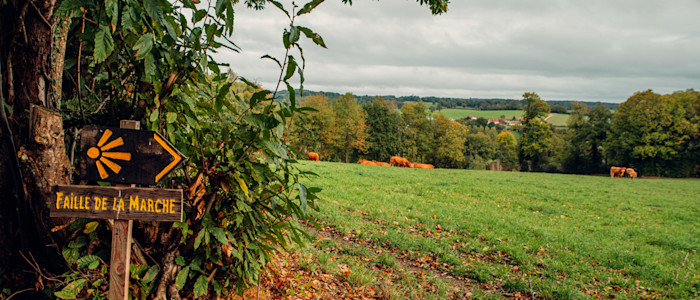
As we pull into the parking lot, we are met by yet another charming local guide. Everyone in La Creuse we have met has been nothing short of wonderful. A “Bonjour” is shared between complete strangers who cross each other’s path. Such a simple act, but one that is sadly lost in many other parts of the world.
We spend the morning hiking up and down what was once an active volcano known as the Faille des Trois Provinces. Well-marked walking & mountain bike trails make this a veritable paradise for outdoor enthusiasts of all ages. Even I, who is known to get lost just about everywhere, could actually find my way around these trails. Which is a rare feat truth be told!
The afternoon is spent at la Chèvrerie du Poney Fringant. This is no ordinary goat farm! It is heartwarming to see the animals treated with such love and respect, all of which is clearly reflected in the smooth & fragrant goat cheese that is produced on-site. Following tons of goat cuddles, a visit to the on-site Reiki cabin and trying some of that mouthwatering goat cheese we head towards our last stop of the day.
Our day ends in Crozant or rather the aptly named Vallée des Peintres which has inspired the likes of Claude Monet, Armand Guillaumin, Francis Picabia. As we head up to the viewpoint overlooking the medieval fortress of Crozant it is not hard to see why our impressionist friends were so inspired. Armed with a local snack – Creusois cake (hazelnut cake) – and a bottle of local wine we sit down to enjoy one of the very best views of the entire trip. If you happen to be in the area with some time to kill, be sure to visit the medieval fortress and to spend some time walking around the charming village of Crozant.
Eating: Le Beau Pré serves excellent local cuisine. Vegetarian options include vegetable tarts and an exquisite onion soup.
Do not miss: Make sure to try the famous Creusois Cake, a hazelnut cake that is simply delicious. Costs around €8 and can be found in but a few traditional bakeries.
Day Four - Aubusson & driving to Dordogne

We head into Aubusson, known for its exceptional craftsmanship when it comes to making tapestries. It is said that many centuries ago a Flemish woman married a local lord and thus the tradition of making tapestries was born. The Cité Internationale de la Tapisserie is the place to be to learn about the various techniques used in the past and present.
We are lucky enough to take a sneak peak into the atelier where the Japanese artist Miyazaki’s works are being women into tapestries, one colorful thread at a time.

Driving into Dordogne (formerly known as the Perigord), we pass a castle every few kilometers. Not surprising as the region is known to hold no less than 1001 castles. Our accommodation for the night is an actual castle, Château de la Meynardie.
Eating: Grab lunch in Aubusson at Chez Armand before hitting the road.
Driving: On the road you will pass the village of Bourganeuf. The Zizim tower is well worth a pitstop
Sleeping: Château de la Meynardie is a privately owned castle that can be rented out for 23 people.
Day Five - Thiviers Market and Brantôme
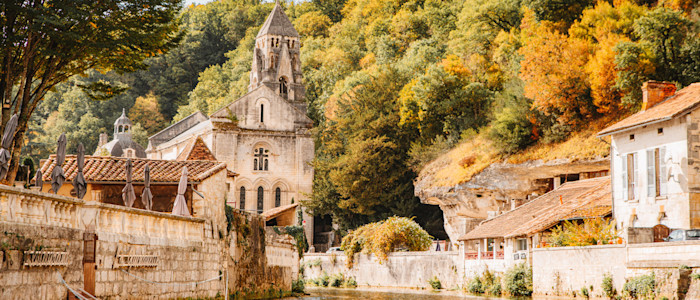
We are lucky enough to visit on a Saturday, when the village of Thivier holds its local market. Plenty of fresh fruits & veggies adorn the stalls on the market square as well as a variety of cheese stalls (we are in France after all). The market is positively bustling, the perfect spot for some good old people watching.
Next up we head towards Brantôme, dubbed the Venice of France. What better way to experience the city than from the water! We hop on a little electrical boat that glides through the Dronne river, the next 50-minutes are spent learning about the history of the city and laughing at the dry humor of our guide (guides speak both English and French).

One cannot leave Brantôme without visiting the 14th-century cloisters, the abbey, the troglodyte caves on the Abbey ground and the obligatory clamber up the church tower. We visit right before closing and have the place to ourselves to wander around. The views from the church tower are simply breathtaking (literally after climbing all 130 steps).
Eating: Grab lunch at Bocaux de Liens in Brantôme. These guys have delicious foods (with plenty of veggie options), adhere to a strict zero-waste and farm-to-table policy.
Sleeping: Le Moulin-du-Roc is a 17th-century former mill that has been transformed into a 4-star hotel. An electric car charger is present on the parking lot.
Day Six - Château de Puyguilhem, Saint-Jean-de-Côle and Saint Mesmin
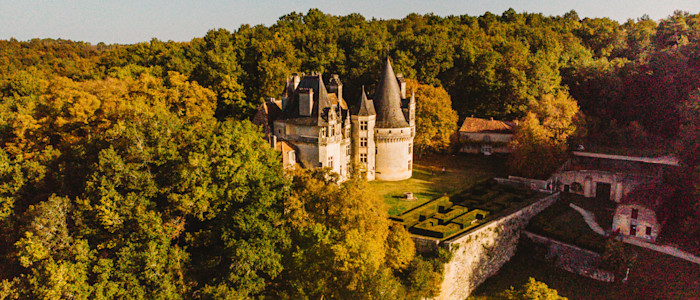
Our last full day in Dordogne kicks off with a visit to the 16th-century Château de Puyguilhem. The Renaissance castle was built as a ‘simple’ hunting lodge for the president of the Parliament. Guided visits are offered once a day at 10.00. Taking a guided tour is well worth it to learn about the history and various legends surrounding the castle.
From the castle we head straight to one of the most beautiful villages in all of France: Saint-Jean-de-Côle. Holy smokes, this microscopic village truly lives up to its title! Languorously strolling through the little alleys, stopping to pet a friendly local cat, we stumble upon the main square which houses the (privately owned) Castle of Marthonia and the – even more impressive – 9th-century Romano Byzantine church. The village square is the perfect spot to sit down and have a glass of delicious (local) wine.

Our last stop of the day takes us back into nature. We park the car in Saint Mesmin and meet up with Romain, our knowledgeable and wonderfully friendly guide for the afternoon. We are hiking down the l’Auvézère gorge in the direction of a waterfall. The lush vegetation offers a cool respite from the warm temperatures. While the well-indicated trails are – once again – a blessing for directionally challenged travelers like myself.
Eating : Le-Saint-Jean in Saint-Jean-de-Côle is great for a quick bite to eat. Limited vegetarian options are available.
Sleeping : La Ferme d’Araucanie is a beautifully restored manor. It houses a little museum dedicated to the agrarian way of living of old.
Additional spots to visit: Chateau de Hautefort
Day Seven - Montignac
For our last day in Dordogne, we set off bright and early in the direction of Montignac. Our destination is the illusive la Distillerie de l’Òrt. An artisanal family-run distillery producing gin and pastis. Master distiller and owner Loïs explains how the distillery came to be, his love for craftmanship and the steps they are undertaking to make the process as sustainable as possible (use of solar panels, thermodynamic water heater,..).
What strikes me is the passion & fervor with which he speaks and the strong ethos to never stop improving their offer (which tasted absolutely wonderful already in my humble opinion). These young entrepreneurs are a true inspiration and show that being eco-friendly does not necessarily need to cost fistfuls of money.
Additional spots to visit: Lascaux caves & Château de Beynac
To conclude
Throughout our journey in bucolic Creuse and the charming Périgord Vert we came across locals striving towards a slower and more sustainable way of life. Be it by using local & seasonal ingredients to cook, by respecting traditional craftsmanship or simply by knowing that more is by no means always better.
Both departments are positively bursting with culture and things to do. Avoid rushing through to tick off your bucket list and instead travel to the local – slower – beat.

